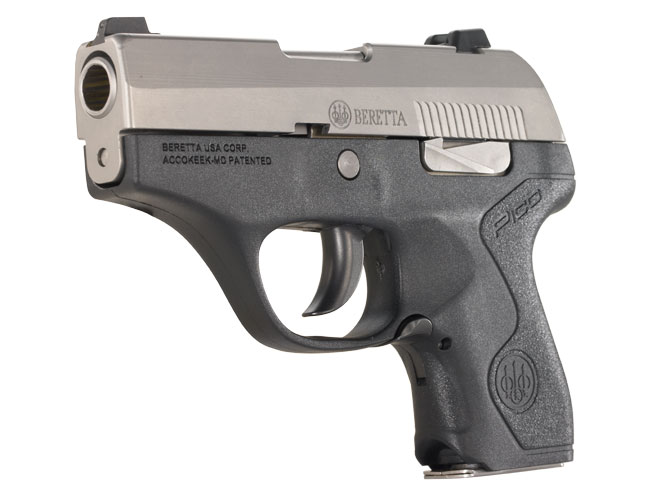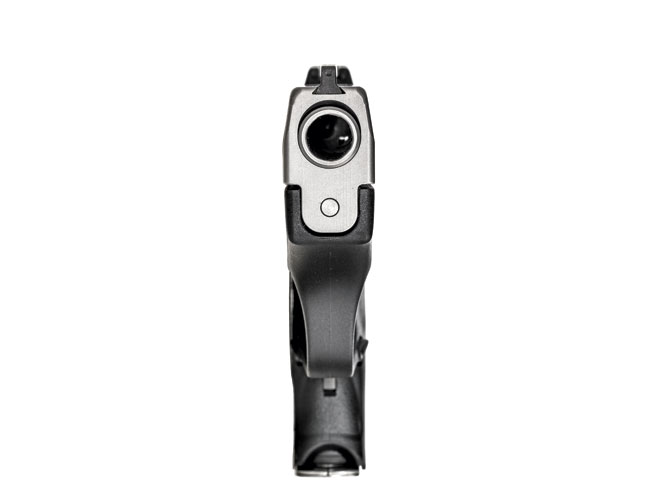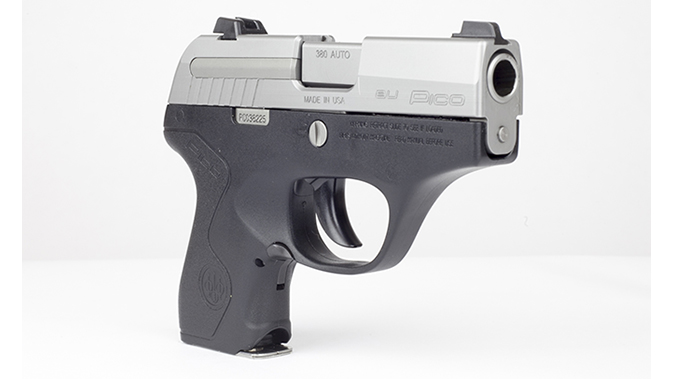Sometimes you don’t quite get it right out of the gate. For Beretta, the innovative Beretta Pico was to be the .380 ACP counterpart to the successful 9mm Nano that was released in 2013. It featured an internal hammer rather than a striker-fired system. The Pico was an excellent design on the surface. However, in order to make it small enough for concealed carry some compromises had to be made.
The thing is, compromise often isn’t part of the original plan. It just happens. The complaints that arose from consumers about the first Beretta Pico’s heavy trigger pull and the effort required to rack the slide, on what was (and remains) the thinnest, most compact, and feature-laden .380 semi-auto pistol ever made, were all well-founded. Beretta took notice. They began reworking the design and, two years later, even followed through on its promise to introduce an unrivaled number of interchangeable accessories.
Pocket Upgrades
Like the Nano, the Beretta Pico has an interchangeable, one-piece, molded polymer frame housing. It also has a removable stainless steel fire control subchassis, which includes frame rails, a trigger, and the internal hammer firing system. Interchangeable subchassis and frames offer multiple variants within a single registered handgun.
Advertisement — Continue Reading Below
The subchassis is considered the actual gun and not what surrounds it. As such, the Pico’s polymer frame can be changed to different colors. The choices are standard black, ranger green, Flat Dark Earth, lavender and pink, as well as two specialized LaserMax frames with a choice of either an integral red laser or a tactical light. The little .380 even has interchangeable, dovetailed white-dot sights that can be switched for optional Beretta Trijicon three-dot night sights. In total, this makes the Pico the single most versatile .380 pistol ever designed.
RELATED STORY: 3 Undercover Berettas – Pico, Nano and PX4 Storm
The Pico also shares another Nano feature—a remarkably simple takedown procedure that requires no levers to rotate, pins to remove or alignment points. In fact, it requires nothing. There’s just one large slotted screw on the right side of the frame. With a one-quarter turn counter-clockwise (using the edge of a shell casing), it allows the slide, barrel, recoil spring, and guide rod assembly to be pulled forward off the frame rails. The screw even automatically rests in the locked position when the slide assembly is slipped back onto the frame rails. It doesn’t get any easier.
Advertisement — Continue Reading Below
Frame & Chassis
Making a frame and chassis swap literally takes about a minute. After performing the takedown procedure and removing the slide assembly, rotate the disassembly screw until the round side is up in the frame (the flat side shows during normal disassembly), press it through the frame and remove it. From there, the fire control chassis lifts out by the front rails and pulls forward out of the frame. To insert it into a new frame, slide the rear of the chassis in first, pull the trigger back enough to drop it into the frame’s trigger opening, and then press the chassis into the frame. Replace the disassembly screw, rotate it to the flat position, and replace the slide. The screw automatically locks back into place. That’s a wrap—you’re done!
.380 Security

The Pico is a hammer-fired semi-auto based on the John M. Browning design utilizing a linkless barrel with a solid camming lug and a squared breechblock face engaging the slide. The locked-breech design is less common in .380s, many of which rely on basic blowback actions (with the barrel affixed to the frame). This would never work with the Pico’s interchangeable frames. In point of fact, there are certain advantages to a locked-breech design over blowback operation, even with a .380 pistol.
Advertisement — Continue Reading Below
The double-action-only Beretta Pico has no manual/external safety. Its trigger design allows second-strike capability. While this is a minor point, in the event of a failed primer, the difference between pulling the trigger again and having to rack the slide can become a major point. Not all .380 semi-autos offer second-strike capability, or even locked-breech double-actions like the Ruger LCP. The Pico’s slide also locks back after the last round. The Beretta does not employ a magazine disconnect, thus it will fire a chambered round without the magazine. The Pico has very good balance in the hand, especially when using the second magazine that comes with the gun, which has a deep finger extension allowing for a full-hand grip, not just a third finger rest like some others.
Fixing a Heavy Trigger
It was the heavier-than-normal trigger pull that first raised attention to the original Beretta Pico’s shortcomings. The original trigger pull was close to a 9-pound average. It was noticeably heavier than the average .380 and nearly 2 pounds more than some DAOs. The revisions to the trigger, which was comprised of lightening the hammer spring, made the new Pico slightly easier to shoot. It has not significantly reduced trigger pull, which still has over an 8-pound average. Travel measures exactly 0.5 inches with zero overtravel and quick reset. This version definitely has a smoother trigger pull but it is still heavy compared to many other DAO .380s.
Revised Recoil Spring Resistance
The second issue was with recoil spring resistance when racking the slide. Beretta USA’s VP of product management explained that the revised recoil spring design lowers racking effort by 10 to 20 percent. This made the gun easier to operate. The new design continues to help mitigate muzzle lift. In combination with Beretta’s straight-line action (requiring the barrel to tilt just 1.4 degrees during the recoil cycle), helps ease recoil with the polymer-framed, 11.5-ounce pistol.
Advertisement — Continue Reading Below
On to the slide release. It is nearly flush with the slide and rests in a recess molded into the polymer frame. While necessary to maintain the Pico’s svelte width, there is barely enough surface area to lay your strong-hand thumb into to release the slide on the reload. If you can get enough thumb pressure on the side of the release during a reload, it will drop easily. Beretta is considering an optional extended slide release lever. While that would increase the width of the Pico by a small degree, “being an option would not alter the Pico’s original specifications,” explained Beretta. A slight increase in width would make the slide release significantly easier to operate.
Out Of Sight

In the world of pocket pistols size matters. When it gets down to fractions of an inch for concealed carry, the Pico earns its name. This is the narrowest semi-auto pistol available, measuring a scant 0.71 inches at it widest point, less than its closest competitor, the Ruger LCP. The Pico’s slide is even a pinch thinner, measuring 0.68 inches. Width is truly the most important feature to look for in a pocket-carry sidearm. The narrower the gun, the less likely it is to print through a pocket.
Advertisement — Continue Reading Below
RELATED STORY: Beretta’s Compact & Subcompact 9mm, .40 S&W, .380 ACP Handguns
The magazine’s finger extension makes the pistol more manageable to draw and shoot by adding a full inch to the height of the gun (which is 3.875 inches with the flush floorplate magazine). In length, the Beretta Pico measures 5.1 inches. This makes it one of the shortest .380s on the market. Overall, the Pico is small enough to holster totally out of sight either in a pocket rig or one of two belt holsters manufactured for Beretta by DeSantis.
Range Time
The ammo selected for the Beretta Pico range test were Sig Sauer’s Elite Performance 90-grain V-Crown JHP, Federal Premium’s 99-grain Personal Defense HST JHP and Hornady’s Critical Defense 90-grain FTX. The target was a B-27 cardboard silhouette set out at a distance of 7 yards with all shots fired at 1-second intervals using a Weaver stance. Although it offered the heaviest grain weight, the Federal 99-grain HST JHP was also the fastest round. It was also the one with the most recoil, clearing the chronograph’s traps at 912-fps average. The 90-grain Hornady JHP and Sig Sauer 90-grain JHP had virtually identical averages through the Pico’s 2.7-inch barrel at 880 fps. When it comes to accuracy, this gun lives at 7 yards, with the best five-round groups all averaging 1 to 1.1 inches, and all with overlapping hits.
Advertisement — Continue Reading Below
The Beretta Pico’s standard white-dot sights are excellent under most lighting conditions, and the optional night sights make this an ideal close-range, 24/7 carry gun. Add the LaserMax red laser or tactical light frames and the Pico is the .380 to beat when it comes to options and features.























